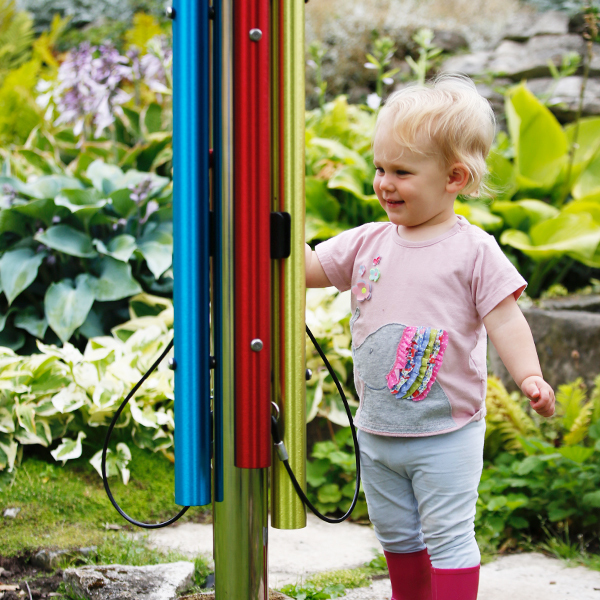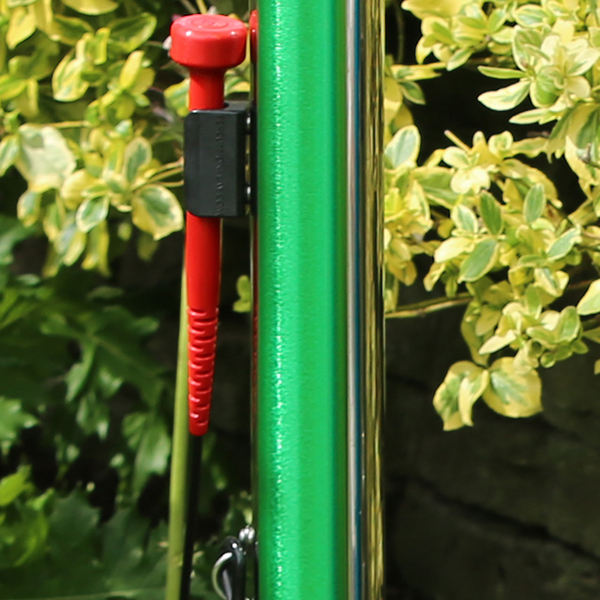Calypso Chimes
Calypso Chimes are practical, durable, and stylish with a wonderful melody and sustain that will liven up any outdoor area. Available as eight individual chimes, in three pre-set arrangements or even mounted to a single post to create a ‘Calypso’ post.
Whether you are looking for solo chimes to place sporadically around your outdoor area to add a colorful musical sound wherever you go, a fun pentatonic set for sensory play or a diatonic arrangement around which outdoor lessons and concerts can be played, Calypso Chimes can be adapted to suit all.
Whether you are looking for solo chimes to place sporadically around your outdoor area to add a colorful musical sound wherever you go, a fun pentatonic set for sensory play or a diatonic arrangement around which outdoor lessons and concerts can be played, Calypso Chimes can be adapted to suit all.
Reminiscent of orchestral tubular bells, the sleek design of the colored anodized aluminium tubing make these chimes outstanding in both sound quality and visual appeal. Using only the highest quality materials, we promise the best quality resonant sound you have ever heard in any outdoor musical chime. Aluminium is one of Earth’s most abundant metals known for its lightness, strength and resistance to corrosion and Calypso Chimes are made of precision-cut high-grade aluminium tubing - constructed to exacting tolerances - with a corrosion-protective anodized finish that will preserve the chime's appearance, increase durability in hostile environments and will never rust.
Nearly a century old, anodising is a relatively straightforward electrochemical process used to increase the thickness of the natural oxide layer on the surface of aluminium. This increases the durability of the metal whilst also giving it a vibrant color. An advantage of the anodised finish is that it is not applied on the surface of the metal. Instead, it is integrated with the aluminium substrate, making it harder than powder coated surfaces and perfect for outdoor spaces. It cannot chip or peel off and is unaffected by sunlight, oxidation, or moisture. It also gives a deeper, richer metallic appearance that is simply not possible with powder coatings. Easy to maintain, anodised aluminium can be cleaned periodically with water and a mild detergent to restore its original lustre. The bright rainbow colors of the Calypso Chimes will capture children’s attention and will also help develop their musical skills. As well as finding bright colored objects more appealing and stimulating, children use colors to help them make sense of what is what. They use color to learn how to match things that are the same and identify things that are similar, but different. This is a very helpful way for young musicians to identify the different pitches on the correlating musical chimes. The Calypso Chimes, along with other instruments in our Rainbow Range use colored notation, where each note of the scale is represented by a different color.
Colors are easy for most young children to recognize and differentiate between, however in music, the baseline is black and white - the colors of standard notation. When first introducing music and music reading to young children it can be challenging for them to recognize patterns and organize the content visually when everything is black and white. Sound and color fit together, and most minds draw intensely vivid connections between the two. For this reason, color can be a helpful tool when teaching music and developing music-reading skills to young children.
It turns out that Newton shared the concept of likening color notation to music notation. To the mediaeval mind, there were just five colours in the rainbow: red, yellow, green, blue, and violet. But Newton added two more – orange and indigo – because he believed that the harmony of colours in the rainbow must be similar to the harmony of notes in a major musical scale. Seven steps in the scale; seven colours in the rainbow.
Nearly a century old, anodising is a relatively straightforward electrochemical process used to increase the thickness of the natural oxide layer on the surface of aluminium. This increases the durability of the metal whilst also giving it a vibrant color. An advantage of the anodised finish is that it is not applied on the surface of the metal. Instead, it is integrated with the aluminium substrate, making it harder than powder coated surfaces and perfect for outdoor spaces. It cannot chip or peel off and is unaffected by sunlight, oxidation, or moisture. It also gives a deeper, richer metallic appearance that is simply not possible with powder coatings. Easy to maintain, anodised aluminium can be cleaned periodically with water and a mild detergent to restore its original lustre. The bright rainbow colors of the Calypso Chimes will capture children’s attention and will also help develop their musical skills. As well as finding bright colored objects more appealing and stimulating, children use colors to help them make sense of what is what. They use color to learn how to match things that are the same and identify things that are similar, but different. This is a very helpful way for young musicians to identify the different pitches on the correlating musical chimes. The Calypso Chimes, along with other instruments in our Rainbow Range use colored notation, where each note of the scale is represented by a different color.
Colors are easy for most young children to recognize and differentiate between, however in music, the baseline is black and white - the colors of standard notation. When first introducing music and music reading to young children it can be challenging for them to recognize patterns and organize the content visually when everything is black and white. Sound and color fit together, and most minds draw intensely vivid connections between the two. For this reason, color can be a helpful tool when teaching music and developing music-reading skills to young children.
It turns out that Newton shared the concept of likening color notation to music notation. To the mediaeval mind, there were just five colours in the rainbow: red, yellow, green, blue, and violet. But Newton added two more – orange and indigo – because he believed that the harmony of colours in the rainbow must be similar to the harmony of notes in a major musical scale. Seven steps in the scale; seven colours in the rainbow.




